2 Background
The study area includes the Bulkley River and Morice River watershed groups (Figure 2.1) and is within the traditional territories of the Gitxsan and Wet’suwet’en.
2.1 Wet’suwet’en
Wet’suwet’en hereditary territory covers an area of 22,000km2 including the Bulkley River and Morice River watersheds and portions of the Nechako River watershed. The Wet’suwet’en people are a matrilineal society organized into the Gilseyhu (Big Frog), Laksilyu (Small Frog), Tsayu (Beaver clan), Gitdumden (Wolf/Bear) and Laksamshu (Fireweed) clans. Within each of the clans there are are a number of kin-based groups known as Yikhs or House groups. The Yikh is a partnership between the people and the territory. Thirteen Yikhs with Hereditary Chiefs manage a total of 38 distinct territories upon which they have jurisdiction. Within a clan, the head Chief is entrusted with the stewardship of the House territory to ensure the Land is managed in a sustainable manner. Inuk Nu’at’en (Wet’suwet’en law) governing the harvesting of fish within their lands are based on values founded on thousands of years of social, subsistence and environmental dynamics. The Yintahk (Land) is the centre of life as well as culture and it’s management is intended to provide security for sustaining salmon, wildlife, and natural foods to ensure the health and well-being of the Wet’suwet’en (Office of the Wet’suwet’en 2013; “Office of the Wet’suwet’en” 2021; FLNRORD 2017).
2.2 Gitxsan
The Gitxsan Laxyip (traditional territories) covers an area of 33,000km2 within the Skeena River and Nass River watersheds. The Laxyip is governed by 60 Simgiigyet (Hereditary Chiefs), within the traditional hereditary system made up of Wilps (House groups). Anaat are fisheries tenures found throughout the Laxyip. Traditional governance within a matrilineal society operates under the principles of Ayookw (Gitxsan law) (“Gitxsan Huwilp Government” 2021).
# Salmon is considered the source of life and always treated with high regard. It was brought by the Raven who also taught people how to fish and hunt.2.3 Project Location
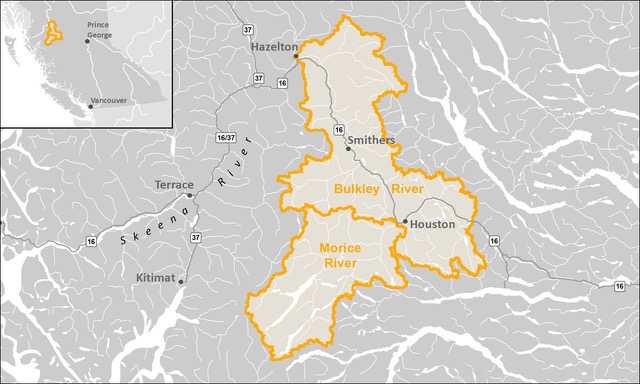
Figure 2.1: Overview map of Study Areas
2.3.1 Bulkley River
The Bukley River is an 8th order stream that drains an area of 7,762 km2 in a generally northerly direction from Bulkley Lake on the Nechako Plateau to its confluence with the Skeena River at Hazleton. It has a mean annual discharge of 138.7 m3/s at station 08EE004 located near Quick (~27km south of Telkwa) and 18.8 m3/s at station 08EE003 located upstream near Houston. Flow patterns at Quick are heavily influenced by inflows from the Morice River (enters just downstream of Houston) resulting in flow patterns typical of high elevation watersheds which receive large amounts of precipitation as snow leading to peak levels of discharge during snowmelt, typically from May to July (Figures 2.2 - 2.3). The hydrograph peaks faster and generally earlier (May - June) for the Upper Bulkley River upstream of Houston where the topography is of lower elevation.
Changes to the climate systems are causing impacts to natural and human systems on all continents with alterations to hydrological systems caused by changing precipitation or melting snow and ice increasing the frequency and magnitude of extreme events such as floods and droughts (IPCC 2014; ECCC 2016). These changes are resulting in modifications to the quantity and quality of water resources throughout British Columbia and are likely to compound issues related to drought and flooding in the Bulkley River watershed where numerous water licenses are held with a potential over-allocation of flows identified during low flow periods (ILMB 2007).
The valley bottom has seen extensive settlement over the past hundred years with major population centers including the Village of Hazelton, the Town of Smithers, the Village of Telkwa and the District Municipality of Houston. As a major access corridor to northwestern British Columbia, Highway 16 and the Canadian National Railway are major linear developments that run along the Bulkley River within and adjacent to the floodplain with numerous crossing structures impeding fish access into and potentially out from important fish habitats. Additionally, as the valley bottom contains some of the most productive land in the area, there has been extensive conversion of riparian ecosystems to hayfields and pastures leading to alterations in flow regimes, increases in water temperatures, reduced streambank stability, loss of overstream cover and channelization (ILMB 2007; Wilson and Rabnett 2007).
plot <- fasstr::plot_longterm_monthly_stats(
station_number = "08EE004",
ignore_missing = TRUE,
add_year = 2021
)
print(plot$`Long-term_Monthly_Statistics`)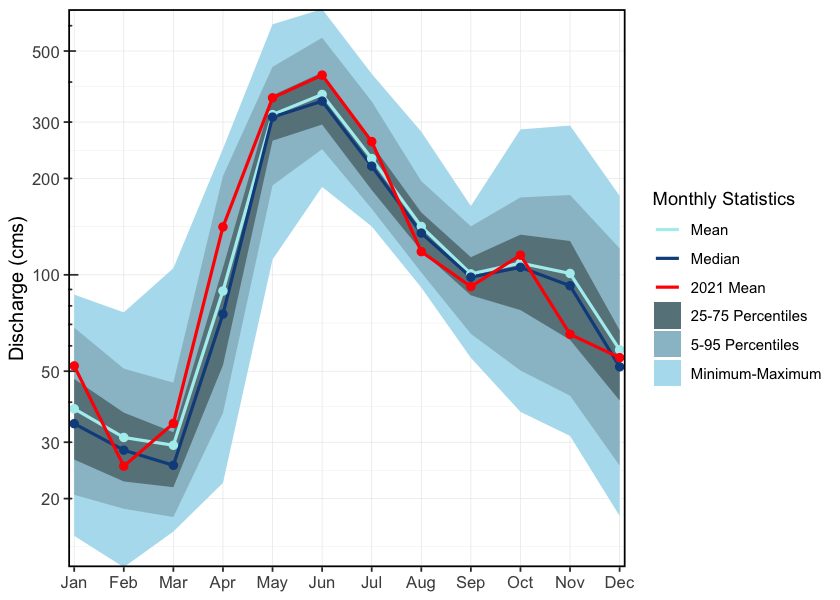
Figure 2.2: Hydrograph for Bulkley River at Quick (Station #08EE004).
plot <- fasstr::plot_longterm_monthly_stats(
station_number = "08EE003",
ignore_missing = TRUE,
add_year = 2021
)
print(plot$`Long-term_Monthly_Statistics`)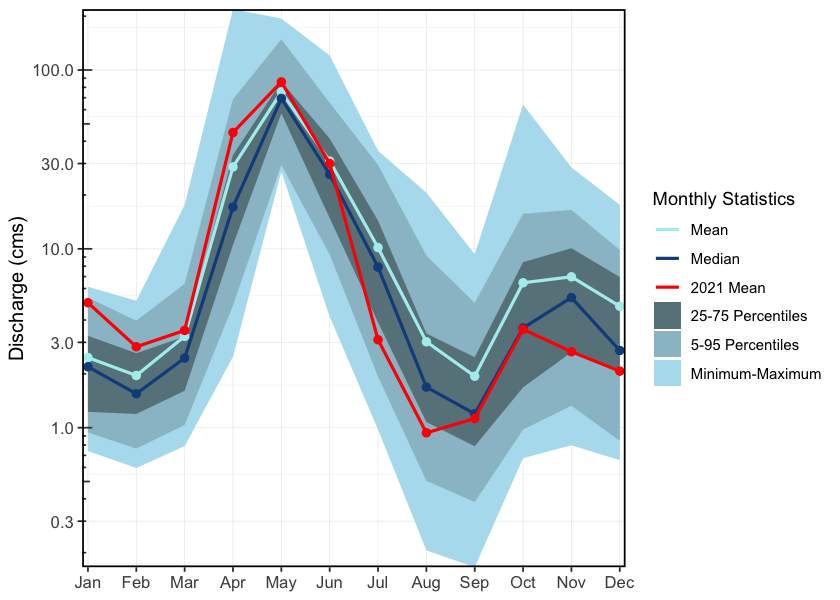
Figure 2.3: Hydrograph for Upper Bulkley River (upstream of confluence with Morice River) near Houston (Station #08EE003).
2.3.2 Morice River
The Morice River watershed drains 4,379 km2 of Coast Mountains and Interior Plateau in a generally south-eastern direction. The Morice River is an 8th order stream that flows approximately 80km from Morice Lake to the confluence with the upper Bulkley River just north of Houston. Major tributaries include the Nanika River, the Atna River, Gosnell Creek and the Thautil River. There area numerous large lakes situated on the south side of the watershed including Morice Lake, McBride Lake, Stepp Lake, Nanika Lake, Kid Price Lake, Owen Lake and others. There is one active hydrometric station on the mainstem of the Morice River near the outlet of Morice Lake and one historic station that was located at the mouth of the river near Houston that gathered data in 1971 only (Environment and limate Change Canada 2021). An estimate of mean annual discharge for the one year of data available for the Morice near it’s confluence with the Bulkley River is 113.3 m3/s. Mean annual discharge is estimated at 75.3 m3/s at station 08ED002 located near the outlet of Morice Lake. Flow patterns are typical of high elevation watersheds influenced by coastal weather patterns which receive large amounts of winter precipitation as snow in the winter and large precipitation events in the fall. This leads to peak levels of discharge during snowmelt, typically from May to July with isolated high flows related to rain and rain on snow events common in the fall (Figure 2.4).
plot1 <- fasstr::plot_longterm_monthly_stats(
station_number = "08ED002",
ignore_missing = TRUE,
add_year = 2021
)
print(plot1$`Long-term_Monthly_Statistics`)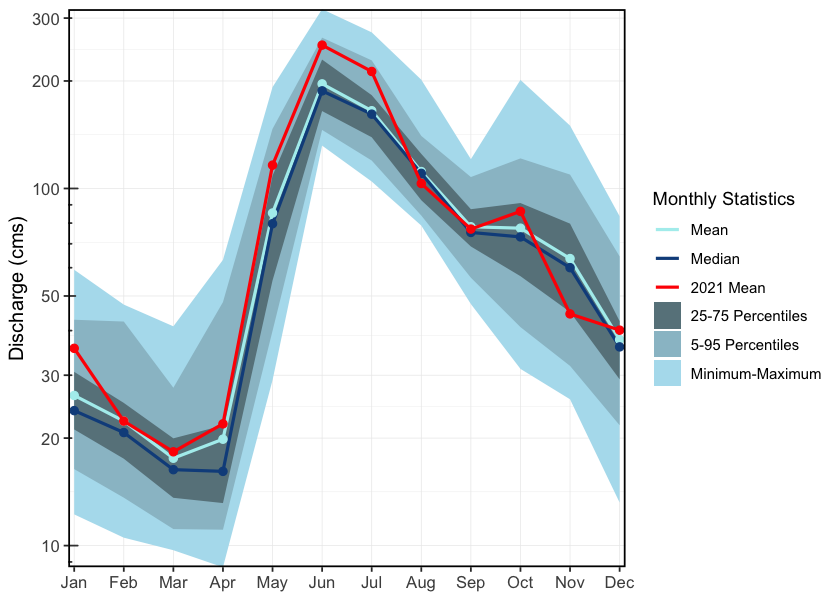
Figure 2.4: Hydrograph for Morice River near outlet of Morice Lake (Station #08ED002).
knitr::include_graphics("fig/hydrograph_08ED003.png")
knitr::include_graphics("fig/pixel.png")
knitr::include_graphics("fig/hydrograph_08ED002.png")2.4 Fisheries
In 2004, IBM Business Consulting Services (2006) estimated the value of Skeena Fisheries at an annual average of $110 million dollars. The Bulkley-Morice watershed is an integral part of the salmon production in the Skeena drainage and supports an internationally renown steelhead, chinook and coho sport fishery (G. C. Tamblyn 2005).
2.4.1 Bulkley River
Traditionally, the salmon stocks passing through and spawning in Bulkley River were the principal food source for the Gitxsan and Wet’suwet’en people living there (Wilson and Rabnett 2007). Wilson and Rabnett (2007) detail numerous fishing areas located within the lower Bulkley drainage (from the confluence of the Skeena to the confluence with the Telkwa River) and the upper Bulkley drainage which includes the mainstem Bulkley River and tributaries upstream of the Telkwa River confluence. Anadromous lamprey passing through and spawning in the upper Bulkley River were traditionally also an important food source for the Wet’suwet’en (Wilson and Rabnett 2007; pers comm. Mike Ridsdale, Environmental Assessment Coordinator, Office of the Wet’suwet’en).
Approximately 11.3 km downstream of the Bulkley Lake outlet and just upstream of Watson Creek, the upper Bulkley falls is an approximately 4m high narrow rock sill that crosses the Bulkley River, producing a steep cascade section. This obstacle to fish passage is recorded as an almost complete barrier to fish passage for salmon during low water flows. Coho have not been observed beyond the falls since 1972 (Wilson and Rabnett 2007).
Renowned as a world class recreational steelhead and coho fishery, the Bulkley River receives some of the heaviest angling pressure in the province. In response to longstanding angler concerns with respect to overcrowding, quality of experience and conflict amongst anglers, an Angling Management Plan was drafted for the river following the initiation of the Skeena Quality Waters Strategy process in 2006 and an extensive multi-year consultation process. The plan introduces a number of regulatory measures with the intent to provide Canadian resident anglers with quality steelhead fishing opportunities. Regulatory measures introduced with the Angling Management Plan include prohibited angling for non-guided non-resident aliens on Saturdays and Sundays, Sept 1 - Oct 31 within the Bulkley River, angling prohibited for non-guided non-resident aliens on Saturdays and Sundays, all year within the Suskwa River and angling prohibited for non-guided non-resident aliens Sept 1 - Oct 31 in the Telkwa River. The Bukley River is considered Class II waterand there is no fshing permitted upstream of the Morice/Bulkley River Confluence (FLNRO 2013a, 2013b; FLNRORD 2019).
2.4.2 Morice River
Detailed reviews of Morice River watershed fisheries can be found in Bustard and Schell (2002), Allen Gottesfeld, Rabnett, and Hall (2002), Schell (2003), A. Gottesfeld and Rabnett (2007), and ILMB (2007) with a comprehensive review of water quality by Oliver (2018). Overall, the Morice watershed contains high fisheries values as a major producer of chinook, pink, sockeye, coho and steelhead.
2.4.2.1 Fish Species
Fish species recorded in the Bulkley River and Morice River watershed groups are detailed in Table 2.1 (MoE 2020a). Coastal cutthrout trout and bull trout are considered of special concern (blue-listed) provincially. Summaries of some of the Skeena and Bulkley River fish species life history, biology, stock status, and traditional use are documented in Schell (2003), Wilson and Rabnett (2007), Allen Gottesfeld, Rabnett, and Hall (2002) and Office of the Wet’suwet’en (2013). Wilson and Rabnett (2007) discuss chinook, pink, sockeye, coho, steelhead and indigenous freshwater Bulkley River fish stocks within the context of key lower and upper Bulkley River habitats such as the Suskwa River, Station Creek, Harold Price Creek, Telkwa River and Buck Creek. Key areas within the upper Bulkley River watershed with high fishery values, documented in Schell (2003), are the upper Bulkley mainstem, Buck Creek, Dungate Creek, Barren Creek, McQuarrie Creek, Byman Creek, Richfield Creek, Johnny David Creek, Aitken Creek and Emerson Creek.
Some key areas of high fisheries values for chinook, sockeye and coho are noted in Bustard and Schell (2002) as McBride Lake, Nanika Lake, and Morice Lake watersheds. A draft gantt chart for select species in the Morice River and Bulkley River watersheds was derived from reviews of the aforementioned references and is included as Figure 2.5. The data is considered in draft form and will be refined over the spring and summer of 2021 with local fisheries technicians and knowledge holders during the collaboratory assessment planning and fieldwork activities planned.
In the 1990’s the Morice River watershed, A. Gottesfeld and Rabnett (2007) estimated that chinook comprised 30% of the total Skeena system chinook escapements. It is estimated that Morice River coho comprise approximatley 4% of the Skeena escapement with a declining trend noted since the 1950 in A. Gottesfeld and Rabnett (2007). Coho spawn in major tributaries and small streams ideally at locations where downstream dispersal can result in seeding of prime off channel habitats including warm productive sloughs and side channels. Of all the salmon species, coho rely on small tributaries the most (Bustard and Schell 2002). Bustard and Schell (2002) report that much of the distribution of coho into non-natal tributaries occurs during high flow periods of May - early July with road culverts blocking migration into these habitats.
##### Chinook
# In the 1990's Morice River watershed, @gottesfeld_rabnett2007SkeenaFish estimated that chinook comprised 30% of the total Skeena system chinook escapements. @buckwalter_kirsch2012Fishinventory have recorded juvenile chinook rearing in small non natal streams.
# @buckwalter_kirsch2012Fishinventory have uvenile chinook have been recorded rearing in small non natal streams
#It is estimated that Morice River coho comprise approximatley 4% of the Skeena escapement with a declining trend noted since the 1950 in @gottesfeld_rabnett2007SkeenaFish. Coho spawn in major tributaries and small streams ideally at locations where downstream dispersal can result in seeding of prime off channel habitats including warm productive sloughs and side channels. Of all the salmon species, coho rely on small tributaries the most [@bustard_schell2002ConservingMorice]. @bustard_schell2002ConservingMorice report that much of the distribution of coho into non-natal tributaries occurs during high flow periods of May - early July with road culverts blocking migration into these habitats.Summaries of historical fish observations in the Bulkley River and Morice River watershed groups (n=4033), graphed by remotely sensed average gradient as well as measured or modelled channel width categories for their associated stream segments where calculated with bcfishpass and bcfishobs and are provided in Figures 2.6 - 2.7.
fiss_species_table <- readr::read_csv(paste0(getwd(), '/data/inputs_extracted/fiss_species_table.csv'))
# filter(`Species Code` != 'CT') %>%
# fiss_species_table %>%
# my_kable(caption_text = 'Fish species recorded in the Bulkley River and Morice River watershed groups.')
#
#
# if(gitbook_on){
# fiss_species_table %>%
# fpr::fpr_kable(caption_text = 'Fish species recorded in the Bulkley River and Morice River watershed groups.')
# } else fiss_species_table[1:41, ] %>%
# fpr::fpr_kable(caption_text = 'Fish species recorded in the Bulkley River and Morice River watershed groups.', scroll = F)
#
# if(identical(gitbook_on, FALSE)){fiss_species_table[42:nrow(fiss_species_table), ] %>%
# fpr::fpr_kable(scroll = F)}
fiss_species_table %>%
fpr::fpr_kable(caption_text = 'Fish species recorded in the Bulkley River and Morice River watershed groups.', scroll = gitbook_on)| Scientific Name | Species Name | Species Code | BC List | Provincial FRPA | COSEWIC | SARA | Bulkley | Morice |
|---|---|---|---|---|---|---|---|---|
| Catostomus catostomus | Longnose Sucker | LSU | Yellow | – | – | – | Yes | Yes |
| Catostomus commersonii | White Sucker | WSU | Yellow | – | – | – | Yes | Yes |
| Catostomus macrocheilus | Largescale Sucker | CSU | Yellow | – | – | – | Yes | Yes |
| Chrosomus eos | Northern Redbelly Dace | RDC | Yellow | – | – | – | Yes | – |
| Coregonus clupeaformis | Lake Whitefish | LW | Yellow | – | – | – | Yes | Yes |
| Cottus aleuticus | Coastrange Sculpin (formerly Aleutian Sculpin) | CAL | Yellow | – | – | – | Yes | Yes |
| Cottus asper | Prickly Sculpin | CAS | Yellow | – | – | – | Yes | Yes |
| Couesius plumbeus | Lake Chub | LKC | Yellow | – | DD | – | Yes | Yes |
| Entosphenus tridentatus | Pacific Lamprey | PL | Yellow | – | – | – | Yes | Yes |
| Hybognathus hankinsoni | Brassy Minnow | BMC | No Status | – | – | – | Yes | – |
| Lota lota | Burbot | BB | Yellow | – | – | – | Yes | Yes |
| Mylocheilus caurinus | Peamouth Chub | PCC | Yellow | – | – | – | Yes | Yes |
| Oncorhynchus clarkii | Cutthroat Trout | CT | No Status | – | – | – | Yes | Yes |
| Oncorhynchus clarkii | Cutthroat Trout (Anadromous) | ACT | No Status | – | – | – | Yes | – |
| Oncorhynchus clarkii clarkii | Coastal Cutthroat Trout | CCT | Blue | – | – | – | Yes | Yes |
| Oncorhynchus gorbuscha | Pink Salmon | PK | Yellow | – | – | – | Yes | Yes |
| Oncorhynchus keta | Chum Salmon | CM | Yellow | – | – | – | Yes | Yes |
| Oncorhynchus kisutch | Coho Salmon | CO | Yellow | – | – | – | Yes | Yes |
| Oncorhynchus mykiss | Rainbow Trout | RB | Yellow | – | – | – | Yes | Yes |
| Oncorhynchus mykiss | Steelhead | ST | Yellow | – | – | – | Yes | Yes |
| Oncorhynchus mykiss | Steelhead (Summer-run) | SST | Yellow | – | – | – | Yes | Yes |
| Oncorhynchus nerka | Kokanee | KO | Yellow | – | – | – | Yes | Yes |
| Oncorhynchus nerka | Sockeye Salmon | SK | Yellow | – | – | – | Yes | Yes |
| Oncorhynchus tshawytscha | Chinook Salmon | CH | Yellow | – | – | – | Yes | Yes |
| Prosopium coulterii | Pygmy Whitefish | PW | Yellow | – | NAR (Nov 2016) | – | Yes | Yes |
| Prosopium coulterii pop. 3 | Giant Pygmy Whitefish | GPW | Yellow | – | – | – | Yes | – |
| Prosopium williamsoni | Mountain Whitefish | MW | Yellow | – | – | – | Yes | Yes |
| Ptychocheilus oregonensis | Northern Pikeminnow | NSC | Yellow | – | – | – | Yes | Yes |
| Pungitius pungitius | Ninespine Stickleback | NSB | Unknown | – | – | – | Yes | – |
| Rhinichthys cataractae | Longnose Dace | LNC | Yellow | – | – | – | Yes | Yes |
| Rhinichthys falcatus | Leopard Dace | LDC | Yellow | – | NAR (May 1990) | – | – | Yes |
| Richardsonius balteatus | Redside Shiner | RSC | Yellow | – | – | – | Yes | Yes |
| Salvelinus confluentus pop. 26 | Bull Trout | BT | Blue | – | – | – | Yes | Yes |
| Salvelinus fontinalis | Brook Trout | EB | Exotic | – | – | – | Yes | Yes |
| Salvelinus malma | Dolly Varden | DV | Yellow | – | – | – | Yes | Yes |
| Salvelinus namaycush | Lake Trout | LT | Yellow | – | – | – | Yes | Yes |
| – | Arctic Char | AC | – | – | – | – | – | Yes |
| – | Cutthroat/Rainbow cross | CRS | – | – | – | – | Yes | – |
| – | Dace (General) | DC | – | – | – | – | – | Yes |
| – | Lamprey (General) | L | – | – | – | – | Yes | Yes |
| – | Minnow (General) | C | – | – | – | – | Yes | Yes |
| – | Salmon (General) | SA | – | – | – | – | Yes | Yes |
| – | Sculpin (General) | CC | – | – | – | – | Yes | Yes |
| – | Sucker (General) | SU | – | – | – | – | Yes | Yes |
| – | Whitefish (General) | WF | – | – | – | – | Yes | Yes |
gantt_raw <- read_csv("data/inputs_raw/fish_species_life_history_gantt.csv")
##start with just the morice to keep it simple
# ungroup()
##start with just the morice to keep it simple
gantt <- gantt_raw %>%
select(Species,
life_stage,
morice_start2,
morice_end2) %>%
filter(
life_stage != 'Rearing' &
life_stage != 'Upstream fry migration' &
!is.na(life_stage),
!is.na(morice_start2)
)%>%
mutate(
morice_start2 = lubridate::as_date(morice_start2),
morice_end2 = lubridate::as_date(morice_end2),
life_stage = factor(life_stage, levels =
c('Migration', 'Overwintering', 'Spawning', 'Incubation', 'Emergence', 'Outmigration')),
life_stage = forcats::fct_rev(life_stage) ##last line was upside down!
) %>%
filter(life_stage != 'Overwintering')
##make a plot
ggplot(gantt, aes(xmin = morice_start2,
xmax = morice_end2,
y = life_stage,
color = life_stage)) +
geom_linerange(size = 2) +
labs(x=NULL, y=NULL)+
# theme_bw()+
ggdark::dark_theme_bw(base_size = 11)+
theme(legend.position = "none")+
scale_x_date(date_labels = "%B")+
facet_wrap(~Species, ncol = 1)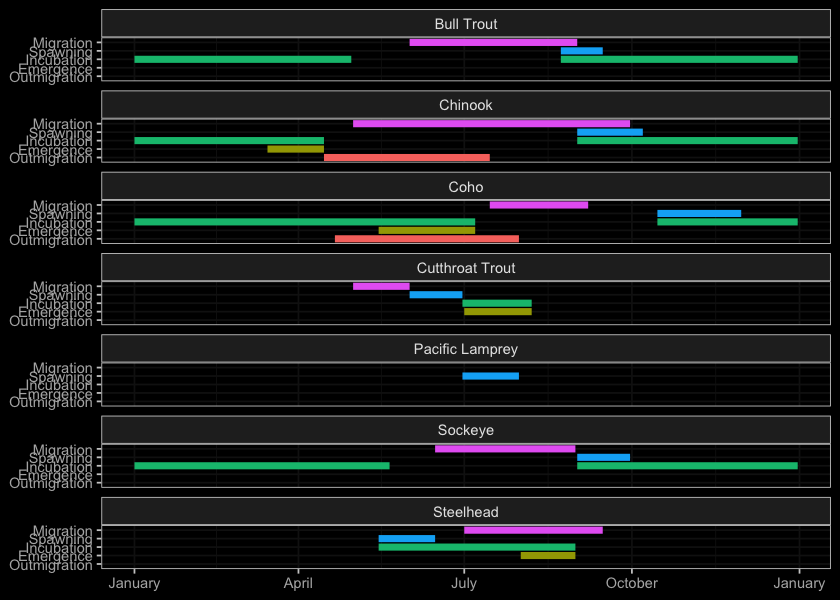
Figure 2.5: Gantt chart for select species in the Morice River and Bulkley River watersheds. To be updated in consultation with local fisheries techicians and knowledge holders.
# fiss_sum <- readr::read_csv(file = paste0(getwd(), '/data/extracted_inputs/fiss_sum.csv'))
fiss_sum_grad <- readr::read_csv(file = paste0(getwd(), '/data/inputs_extracted/fiss_sum_grad.csv'))
fiss_sum_width <- readr::read_csv(file = paste0(getwd(), '/data/inputs_extracted/fiss_sum_width.csv'))
# A summary of historical westslope cutthrout trout observations in the Elk River watershed group by average gradient category of associated stream segment is provided in Figure \@ref(fig:fish-wct-bar). Of `r wct_elkr_grad %>% filter(gradient_id == 3) %>% pull(total)` observations, `r wct_elkr_grad %>% filter(gradient_id == 3) %>% pull(Percent) + wct_elkr_grad %>% filter(gradient_id == 5) %>% pull(Percent) + wct_elkr_grad %>% filter(gradient_id == 8) %>% pull(Percent)`% were within stream segments with average gradients ranging from 0 - 8%. A total of `r wct_elkr_grad %>% filter(gradient_id == 3) %>% pull(Percent)`% of historic observations were within stream segments with gradients between 0 - 3%, `r wct_elkr_grad %>% filter(gradient_id == 5) %>% pull(Percent)`% were within stream segments with gradients ranging from 3 - 5% and `r wct_elkr_grad %>% filter(gradient_id == 5) %>% pull(Percent)`% were within stream segments with gradients between 5 - 8% [@data_fish_obs; @norris2021smnorrisbcfishobs]. ##bar graph
plot_grad <- fiss_sum_grad %>%
filter(gradient_id != 99) %>%
ggplot(aes(x = Gradient, y = Percent)) +
geom_bar(stat = "identity")+
facet_wrap(~species_code, ncol = 2)+
ggdark::dark_theme_bw(base_size = 11)+
labs(x = "Average Stream Gradient", y = "Occurrences (%)")
plot_grad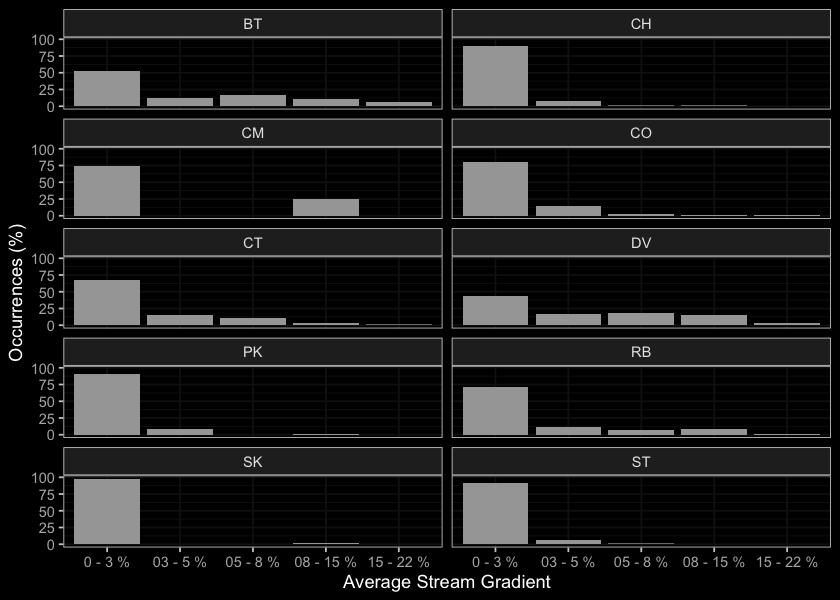
Figure 2.6: Summary of historic salmonid observations vs. stream gradient category for the Bulkley River watershed group.
##bar graph
plot_width <- fiss_sum_width %>%
filter(!is.na(width_id)) %>%
ggplot(aes(x = Width, y = Percent)) +
geom_bar(stat = "identity")+
facet_wrap(~species_code, ncol = 2)+
ggdark::dark_theme_bw(base_size = 11)+
labs(x = "Channel Width", y = "Occurrences (%)")
plot_width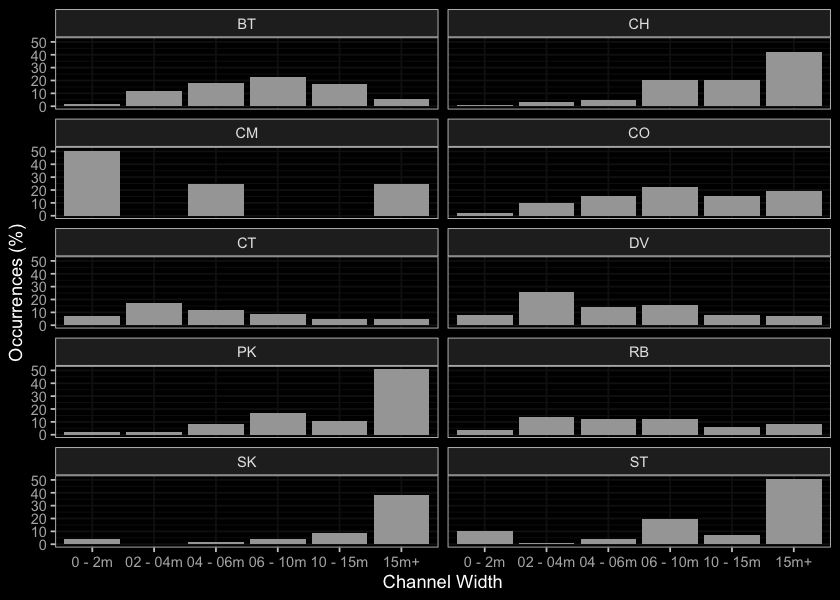
Figure 2.7: Summary of historic salmonid observations vs. channel width category for the Bulkley River watershed group.
##bar graph
fiss_sum_wshed_filter <- fiss_sum %>%
filter(upstream_area_ha < 5000) %>%
mutate(upstream_area_km = upstream_area_ha/100)
bin_1 <- 0
# bin_1 <- floor(min(fiss_sum_wshed_filter$upstream_area_ha, na.rm = TRUE)/5)*5
bin_n <- ceiling(max(fiss_sum_wshed_filter$upstream_area_km, na.rm = TRUE)/5)*5
bins <- seq(bin_1,bin_n, by = 5)
plot_wshed_hist <- ggplot(fiss_sum_wshed_filter, aes(x=upstream_area_km
# fill=alias_local_name
# color = alias_local_name
)) +
geom_histogram(breaks = bins,
position="identity", size = 0.75)+
labs(x = "Upstream Watershed Area (km)", y = "Count Fish (#)") +
facet_wrap(~species_code, ncol = 2)+
# scale_color_grey() +
# scale_fill_grey() +
ggdark::dark_theme_bw(base_size = 11)+
scale_x_continuous(breaks = bins[seq(1, length(bins), by = 2)])+
# scale_color_manual(values=c("grey90", "grey60", "grey30", "grey0"))+
# theme(axis.text.x = element_text(angle = 45, hjust = 1))+
geom_histogram(aes(y=..density..), breaks = bins, alpha=0.5,
position="identity", size = 0.75)
plot_wshed_hist2.5 Fish Passage Restoration Planning and Implementation
As a result of high-level direction from the provincial government, a Fish Passage Strategic Approach protocol has been developed for British Columbia to ensure that the greatest opportunities for restoration of fish passage are pursued. A Fish Passage Technical Working Group has been formed to coordinate the protocol and data is continuously amalgamated within the Provincial Steam Crossing Inventory System (PSCIS). The strategic approach protocol involves a four-phase process as described in Fish Passage Technical Working Group (2014) :
- Phase 1: Fish Passage Assessment – Fish stream crossings within watersheds with high fish values are assessed to determine barrier status of structures and document a general assessment of adjacent habitat quality and quantity.
- Phase 2: Habitat Confirmation – Assessments of crossings prioritized for follow up in Phase 1 studies are conducted to confirm quality and quantity of habitat upstream and down as well as to scope for other potential nearby barriers that could affect the practicality of remediation.
- Phase 3: Design – Site plans and designs are drawn for priority crossings where high value fish habitat has been confirmed.
- Phase 4: Remediation – Re-connection of isolated habitats through replacement, rehabilitation or removal of prioritized crossing structure barriers.
2.5.1 Bulkley River
There is a rich history of fish passage restoration planning in the Bulkley River watershed group with not all the work documented in the PSCIS system. A non-exhaustive list of historic fish passage reports for the watershed includes Wilson and Rabnett (2007), McCarthy and Fernando (2015),Smith (2018) Casselman and Stanley (2010) and Irvine (2018).
Review of the PSCIS database indicated that prior to 2021, 1665 assessments for fish passage (Phase 1) at crossing structures within the Bulkley River watershed group have been recorded in the PSCIS database (MoE 2021a). No habitat confirmations are recorded in the PSCIS database (MoE 2021b). Within the Bulkley River watershed group, a number of remediation projects have been completed over the years with backwatering works conducted on Toboggan Creek, Coffin Creek, Moan Creek, Johnny David Creek and potentially others. Three culvert replacements (with open bottom structures) in the watershed group have been tracked in PSCIS and include works on Barren Creek as well as two tributaries to Harold Prince Creek (MoE 2021c). McDowell Creek at Highway 16 was replaced with a horizontally drilled baffled structure in 2017 and a design is currently being drafted for the Highway 16 crossing over Taman Creek (pers. comm. Kathryn Graham, Regional Manager Environmental Services - Ministry of Transportation and Infrastructure).
##`r pscis_historic_phase1 %>% filter(watershed_group_code %ilike% 'BULK' & assessment_date < '2020-01-01') %>% nrow()`2.6 Morice river
Within the Morice River watershed group prior to 2021, 21 fish passage assessments (Phase 1) had been recorded in the PSCIS database (MoE 2021a). At the time of reporting, no habitat confirmations had been recorded (MoE 2021b). Two culvert replacements (with open bottom structures) in the watershed group have been tracked in PSCIS in the and include works on a tributary to the Morice River located at km 39.2 of the Morice River FSR and on bridge installation at km 4 of McBride Road on a tributary to McBride Lake (MoE 2021c).